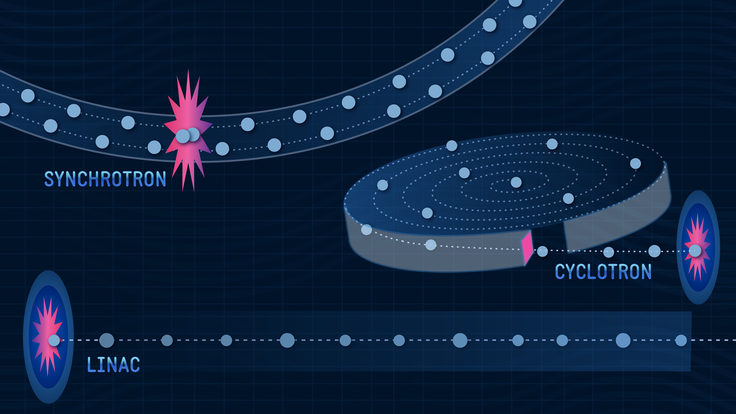 |
by Monica Bobra
More than 500 tons of niobium would go into building the ILC. What's so great about niobium? Where does it come from? And is the Earth's supply going to run out?
Araxá, Brazil, sits atop the world's largest supply of niobium. As far as particle physicists are concerned, it might as well be a gold mine. The future International Linear Collider (ILC) would use over 500 tons of pure niobium to build 20,000 superconducting radio-frequency (rf) cavities, devices that accelerate electrons and their antimatter twins, positrons, along microwaves to near-light speeds.
That means metal-refining factories would have to work at full capacity for three to four years solely to create highly-refined niobium for the ILC. Currently at three hundred dollars a pound, the niobium alone would cost the ILC upwards of three hundred million dollars—though technological developments might reduce the price tag. And it's all in the name of superconductivity.
Superconductors
At 9.2 Kelvin, niobium acts as a superconductor— a substance with no electrical resistance. In these materials, electrons move more smoothly than skates on ice. But cooling the materials isn't easy. The process requires isolating the metal in a vacuum chamber and using liquid helium as a coolant. Because niobium superconducts at a temperature warmer than any other metal, it's the easiest to cool. That's why it's attractive.
Using niobium in accelerators isn't anything new. Scientists at the Westinghouse Electric Company developed niobium-titanium superconducting wire in 1962; soon after, Rutherford Appleton Laboratory scientists used the wire to design magnets. Fermilab's Tevatron, a superconducting accelerator, first used these magnets in 1987. A host of accelerators followed suit.
However, ILC's superconducting rf cavities would be solid niobium. The difference lies in each instrument's purpose: magnets guide particle beams, whereas rf cavities accelerate them.
Pure niobium isn't good for stabilizing a magnetic field. Superconducting magnets need traces of titanium to hold magnetic fields in place. But pure niobium is great for accelerating microwaves. When cooled down to superconducting temperatures, pure niobium rf cavities lose their resistance, sustaining microwave energy for long periods of time. The lower the grade of niobium, the more the microwaves lose energy by dissipating into heat.
 Naming niobium In 1801, Englishman Charles Hatchett analyzed an unknown metal from the United States and decided to call it columbium. Forty-three years later, the German mineralogist Heinrich Rose discovered the element again, which he named after Niobe, granddaughter of Zeus. As the Greek myth goes, Niobe boasted about her children so much that Apollo and Artemis killed them, causing her to weep until she turned into stone. Because Rose's discovery was identical to Hatchett's, it spawned another conflict. For over a century, chemists argued about what to call the element: niobium or columbium. The International Union of Pure and Applied Chemists (IUPAC) officially adopted the name niobium in 1950 but the name colombium is still used at times, especially by US commercial producers of the metal. |
Mining
Most of the ILC's niobium would originate as pyrochlore (NaCaNb2O6F), a niobium oxide, in grounds beneath Araxá and Saint Honoré, Quebec. There, in open pits of dirt that contain just three percent niobium, miners go to work. First, they extract and enrich the pyrochlore. Then it undergoes an explosive chemical reaction with aluminium, which produces aluminium oxide and liquid niobium—with a lot of impurities. The liquid niobium is cooled into tree-trunk shaped ingots.
Then the ingots usually travel to metal-refining factories, where they're purified further. Several electron-beam guns melt the metal. Impurities evaporate. Liquid niobium drops into a crucible, a vacuum-sealed copper container, that cools the niobium into pure ingots. But the fabrication isn't over. Like giant rolling pins, machines compress the metal multiple times. The now-flattened sheet metal enters an annealing furnace, which makes the niobium perfectly uniform.
Engineering
Now scientists are working to design the perfect niobium rf cavity for the ILC. In June, Jefferson Laboratory scientists made a smaller-scale working model of the rf cavities, by plying single niobium crystals into dome-shapes and welding them together. Metal-refining factories can create 7.5-inch-diameter single crystals of niobium during the electron-beam process. But those factories are trying to up the ante and create 10.5-inch-diameter crystals so the ILC would not have to pay for the rolling pin and annealing furnace processes of niobium refining, says Jefferson Lab scientist Peter Kneisel.
Cooling the rf cavities is also a challenge. The lower its temperature, the better niobium acts as a superconductor. As a result, ILC rf cavities would operate at a chilly two degrees Kelvin. The process would require about two million liters of liquid helium at about US$3 per liter.
"It's like a refrigerator," says Fermilab cryogenic engineer Tom Peterson. "The helium is the coolant, like Freon [gas] in a household refrigerator." Liquid helium will turn into gas as it cools the rf cavities. The gas is then collected and condensed back into a liquid. In this way, the ILC would recycle its liquid helium. Though some may leak out, says Peterson, the losses are predicted to be minimal.
Supply
The niobium necessary for the ILC would barely make a dent in the world's supply. According to the US Geological Survey, nearly ninety percent of the United States' niobium supply comes from Brazil and Canada, which collectively mine some 32,000 tons of material annually. The steel industry uses most of it in low-grade form as a strengthening agent.
This May, the mining business Companhia Brasileira de Metalurgia e Mineração decided to increase its niobium output. Now, some 70,000 tons of niobium per year are predicted to be recovered from Araxá. "The quantities available in these sources are enormous," says Cornell University particle physicist Hasan Padamsee. "It's enough to last the world hundreds of years." And it's certainly enough to meet the ILC's needs.
Click here to download the pdf version of this article.






